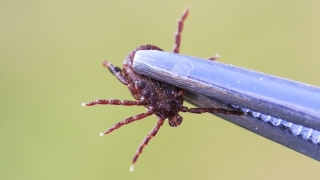Lyme Disease in Children
What is Lyme disease?
Lyme disease is a multistage, multisystem bacterial infection caused by the Borrelia burgdorferi bacterium. It is transmitted by the bite of blacklegged tick (or deer tick, Ixodes scapularis).
Blacklegged ticks can be as small as a poppy seed, making it extremely difficult to spot them on the body. Blacklegged ticks are very common in certain areas in the United States including:
- The northeast (New York to Maine)
- The mid-Atlantic states (Virginia to New Jersey)
- The north central states of Wisconsin and Minnesota
- Northern California
Lyme disease was first reported in the U.S. in 1977, in Old Lyme, CT, giving the disease its name. Blacklegged ticks are most often found in wooded and grassy areas, but can be transported by animals to other areas.
By using insect repellents, wearing clothes that cover exposed body parts, and washing, inspecting, and removing any ticks from your child’s skin promptly, you can help prevent tick bites and the potential of developing Lyme disease.
Cause
Lyme disease is caused by the Borrelia burgdorferi bacterium, which is transmitted through the bite of infected blacklegged tick. Ticks can attach to any part of the body and are often found in hard-to-see areas such as the groin, armpits and scalp.
In order for the Lyme disease bacterium to be transmitted into your child’s skin, a tick must be attached for 36 to 48 hours or more. Most people are infected by the bite of an immature tick called a nymph. Blacklegged nymph ticks are tiny — less than 2 millimeters in length — and are very difficult to see with the naked eye. They feed during the spring and summer months when children and adults are more likely to be outdoors.
Adult ticks can also transmit Lyme disease. They are larger than nymphs — about the size of a sesame seed — and more easily spotted with the naked eye. Adult ticks are most active during the cooler months of the year.
Signs and symptoms of Lyme disease
Once infected with the Borrelia burgdorferi bacterium, your child may display a range of nonspecific symptoms that mimic other conditions. Symptoms can also change over time, making diagnosis more challenging. If left untreated, the infection can spread to other parts of the body, potentially causing long-term medical issues and permanent damage.
Common symptoms of Lyme disease within the first 30 days after a tick bite include:
- A circular-shaped, “bull’s-eye” rash called erythema migrans. It can be pink or clear in the center and red on the surrounding skin. This rash:
- Can last up to several weeks
- Can vary in size from around 2 to 12 inches across
- Can mimic skin problems such as hives, eczema, sunburn, poison ivy, or flea bites
- Can itch or feel hot, or may not be felt at all
- Can disappear and then return several weeks later
- Flu-like symptoms, such as:
- Fever
- Chills
- Muscle and joint aches
- Fatigue
- Swollen glands
If the infection spreads to other parts of the body, your child may experience additional symptoms such as:
- Severe headaches and neck stiffness
- Additional circular, “bull’s-eye” rashes on other areas of the body
- Arthritis with severe joint pain and swelling, particularly in the knees and other large joints
- The loss of muscle tone or a droop on one or both sides of the face (called facial of Bell’s palsy)
- Intermittent pain in muscles, joints, tendons and bones
- Heart palpitations or an irregular heart beat (Lyme carditis)
- Episodes of dizziness or shortness of breath
- Inflammation of the brain and spinal cord
- Nerve pain
- Shooting pain, numbness, or tingling in the hands or feet
- Problems with short-term memory
- Eye inflammation including uveitis
Testing and diagnosis
In most cases, Lyme disease is diagnosed based on your child’s symptoms, a physical examination, and a history of exposure to blacklegged ticks (i.e. living in or traveling to areas where the ticks are found).
If your child has symptoms of Lyme disease but no indication of a tick bite, your child’s doctor may order blood tests to determine if your child’s immune system is producing specific antibodies to fight the Borrelia burgdorferi bacterium. Blood tests are most effective two to six weeks after a tick bite when the body’s immune system has time to react.
Children tested within a few days of a tick bite may be “negative” for antibodies, yet still have the bacterium growing in them just not yet at measureable levels. For this reason, early diagnosis of Lyme disease is often based solely on the observation of the classic Lyme disease “bull’s-eye” rash, which develops in 70 to 80 percent of infected individuals.
Other tests may be needed if the Lyme disease infection has spread beyond the skin, such as:
- Electrocardiography (ECG or EKF), if Lyme carditis is suspected
- Magnetic resonance imaging (MRI) of the brain if Lyme meningitis is suspected
- Lumbar puncture (spinal tap) if symptoms of Lyme meningitis occur
At Children’s Hospital of Philadelphia, our experienced pediatricians and rheumatologists are experts at diagnosing Lyme disease and other conditions that mimic its symptoms. Making the correct diagnosis in a timely manner means your child can get the appropriate treatment faster.
If your child has Lyme disease, we will ensure appropriate treatment to eradicate the Lyme disease infection. If your child does not have Lyme disease, we will work to determine the true cause of your child’s illness and avoid the misdiagnosis and treatment of Lyme disease when it is not necessary.
Treatments
Treatment with appropriate antibiotics in the early stages of Lyme disease leads to rapid and complete resolution of symptoms without permanent damage. Oral antibiotics that are commonly used to treat Lyme disease include doxycycline, amoxicillin or cefuroxime, and are typically given as a two- to four-week course, depending on the stage of the infection.
Lyme disease typically responds very well to antibiotics, but if symptoms have not resolved after the initial course of antibiotics, a second course of antibiotics is sometimes necessary.
Individuals with neurologic or cardiac involvement may require IV antibiotics. Children with cardiac, joint or brain involvement from Lyme disease may need additional follow-up with pediatric specialists.
Outlook
Patients with Lyme disease who complete a full course of antibiotics as recommended typically do not have lasting or long-term consequences from their illness. If symptoms persist despite antibiotic treatment, alternative diagnoses must be considered. Long-term (i.e. many months) IV antibiotics have not been shown to be of benefit.
If your child has had a Lyme infection, your child’s body will continue to produce antibodies to the Lyme disease infection long after the disease is completely treated. This does not mean that your child still has an active infection, rather that your child’s body continues to actively fight against any possible re-infection by the Lyme disease-causing bacterium.
Children who developed “bull’s eye” rashes and were treated early in the course of a Lyme disease infection, re-infection is possible after treatment. This is because the antibiotics cleared the infection before your child’s body could develop protective immunity against future Lyme disease infections.
Lyme disease prevention
The best way to prevent Lyme disease is by avoiding tick bites altogether. Despite your best efforts, a tick may still find your child. That’s why it’s so important to regularly check your family for ticks and properly remove any ticks you find.
Preventing tick bites
Some tips to avoid tick bites:
- Avoid areas where ticks live. Remind your child to walk on cleared paths and pavement through wooded areas and fields whenever possible.
- Wear a hat, long pants and long sleeves when walking in shaded, wooded areas. It’s important to cover all exposed skin, even in the summer.
- Pull your child’s hair back in a ponytail or tucked into a cap. Ticks can’t jump from trees or fly, but they can crawl up your child’s hair.
- Use insect repellents safely. Products that contain DEET are tick repellents, but aren’t 100 percent effective. Use a children's insect repellent (10 to 30 percent DEET) for your child. You can apply it to shirt collars, sleeves, and pant cuffs as well as exposed skin. Do not use repellent on infants less than 1 year of age. Do not apply to the area around your child's nose, mouth and eyes. Do not apply over any cuts or open sores.
- Be safe with products that contain DEET.
- Do not allow children less than 10 years of age to apply repellent themselves.
- Do not apply to young children’s hands or around eyes and mouth.
- Do not breathe in, swallow or get into the eyes (DEET is toxic if swallowed).
- Do not put repellent on wounds or broken skin.
- Encourage your child to shower as soon as possible after coming indoors. Showering will help to remove unattached ticks.
Check for ticks
If you live in or are visiting an area where Lyme disease infections have been reported, it is important to check your family often for ticks, including your pets. Places to check include:
- Common tick hideouts, such as the belly button, in and behind the ears, on the neck, at the hairline, armpits, groin and the scalp.
- Parts of the body that bend, such as behind the knees, between fingers and toes, underarms and groin.
- Areas of pressure points, such as where elastic waistbands touch the skin, where clothing presses on the skin.
Visually check all other areas of the body and hair, and run fingers gently over skin. Run a fine-toothed comb through your child's hair to check for ticks daily.
What to do if you find a tick
If you see a tick, try to remove it from your child’s body. If the tick was on the body for less than 36 hours, it may help prevent infection.
To safely remove a tick:
- Use fine-tipped tweezers to grasp the tick at its head or mouth, close to the skin.
- Pull firmly on the tick until it releases the skin. Try to ease out any parts that get stuck in the skin.
- Wash the bite area with rubbing alcohol or soap and water and apply an antiseptic lotion or cream.
Reviewed by Jay Mehta, MD, MS



